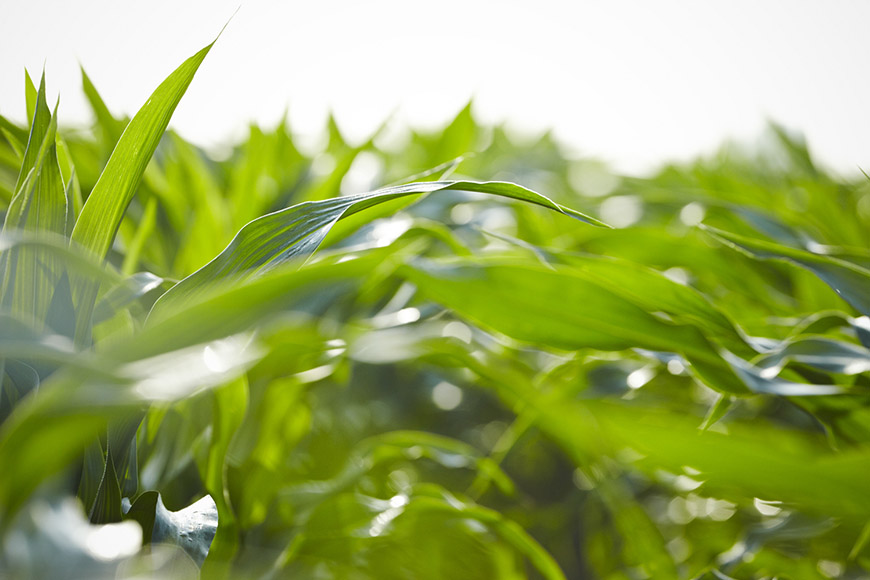Dealing With Drought

A number of states in the northern Corn Belt are experiencing dry weather now or the results of earlier dry weather, especially where I am based in Illinois. Much of the country had a wetter-than-normal spring, which caused delayed planting in many areas. Follow that wet spring with drought conditions and we’re seeing poor, shallow root growth that is perhaps made worse by more recent dry conditions in some areas.
Here’s a look at how drought conditions can affect crops and what you can do to mitigate these stresses.
Crop stress symptoms
It’s important to keep in mind that crop stress due to drought occurs before there are any visual symptoms. Roots in the soil are the first to detect water limitation. When they do, they transmit a signal to the rest of the plant to start shutting down, limiting growth and reproductive development to conserve water.
A classic visual indication of water limitation is leaf rolling, especially in the middle of the day when it is hottest. Leaf rolling may persist for most of the day if drought conditions continue or worsen.
Limit crop stress
Much of our region is nearing tasseling and silk emergence, which is when a corn plant uses the most water during its life cycle. This tremendous demand for water, about 0.35 inch per day, means that limitations in water have a direct impact on that plant’s growth.
Biostimulants such as Toggle® help regulate the water balance of the plant, particularly during times of drought or heat stress. This is accomplished by stimulating more responsive stomata, which are responsible for the flow of nutrients and water through the plant, known as stomatal conductance. Essentially, Toggle® helps regulate the flow of water through and out of the plant in a more efficient manner.
Toggle® can be used during a range of growth stages from v5 through tasseling, and can be applied multiple times throughout a growing season when conditions warrant it. Biostimulants such as Toggle® have a direct impact on the gene expression of the plant, which means that the optimal timing is to anticipate stress and apply it early-on. However, the product can still benefit plants if applied later on.
Farmers can also consider other stress mitigation tools, like strobilurin fungicides, which have shown to not only control diseases but also to have a positive impact on the corn crop’s physiology and final yield potential.
Looking ahead and preparing for next year
Farmers in parts of the country that regularly experience drought stress and/or anticipate stress should use a systems approach to manage water for their crops. That can involve better seed selection (selecting hybrids that are genetically adapted to be more tolerant to stresses like drought or high temperatures). In-season, use best agronomic practices such as biostimulants and fungicides to preserve the yield potential of those genetics.
To learn more about drought stress mitigation tools, contact your local WinField United retailer.
Here’s a look at how drought conditions can affect crops and what you can do to mitigate these stresses.
Crop stress symptoms
It’s important to keep in mind that crop stress due to drought occurs before there are any visual symptoms. Roots in the soil are the first to detect water limitation. When they do, they transmit a signal to the rest of the plant to start shutting down, limiting growth and reproductive development to conserve water.
A classic visual indication of water limitation is leaf rolling, especially in the middle of the day when it is hottest. Leaf rolling may persist for most of the day if drought conditions continue or worsen.
Limit crop stress
Much of our region is nearing tasseling and silk emergence, which is when a corn plant uses the most water during its life cycle. This tremendous demand for water, about 0.35 inch per day, means that limitations in water have a direct impact on that plant’s growth.
Biostimulants such as Toggle® help regulate the water balance of the plant, particularly during times of drought or heat stress. This is accomplished by stimulating more responsive stomata, which are responsible for the flow of nutrients and water through the plant, known as stomatal conductance. Essentially, Toggle® helps regulate the flow of water through and out of the plant in a more efficient manner.
Toggle® can be used during a range of growth stages from v5 through tasseling, and can be applied multiple times throughout a growing season when conditions warrant it. Biostimulants such as Toggle® have a direct impact on the gene expression of the plant, which means that the optimal timing is to anticipate stress and apply it early-on. However, the product can still benefit plants if applied later on.
Farmers can also consider other stress mitigation tools, like strobilurin fungicides, which have shown to not only control diseases but also to have a positive impact on the corn crop’s physiology and final yield potential.
Looking ahead and preparing for next year
Farmers in parts of the country that regularly experience drought stress and/or anticipate stress should use a systems approach to manage water for their crops. That can involve better seed selection (selecting hybrids that are genetically adapted to be more tolerant to stresses like drought or high temperatures). In-season, use best agronomic practices such as biostimulants and fungicides to preserve the yield potential of those genetics.
To learn more about drought stress mitigation tools, contact your local WinField United retailer.

